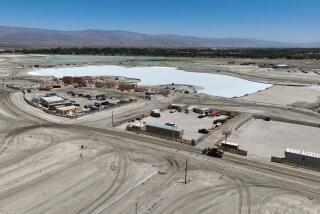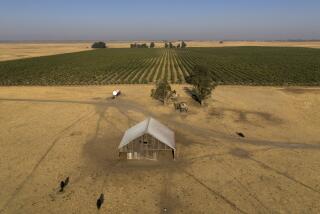Environmentalists Challenge CSU Impact Report
- Share via
Despite an ambitious proposal to turn the future Cal State Channel Islands University into the first “green campus” in the state system, local environmentalists are challenging several points in a final environmental study released Thursday.
They are urging university officials to scratch plans for a nine-hole golf course, 350,000 square feet of office space and 900 nonstudent residential units proposed at the former Camarillo State Hospital complex. Much of the 630-acre site is surrounded by agricultural land and thousands of acres of wilderness, where deer and other wildlife live.
For the record:
12:00 a.m. Sept. 5, 1998 For the Record
Los Angeles Times Saturday September 5, 1998 Ventura County Edition Metro Part B Page 5 Zones Desk 1 inches; 26 words Type of Material: Correction
Cal State start--A story Friday included inaccurate information on the target date for completing the new Cal State Channel Islands. The first phase should be completed by fall 1999.
“A golf course is completely unnecessary,” wrote Kim Uhlich, an analyst at the Environmental Defense Center, in the 101-page report. “The area should be left as open space with a guarantee that it be left so in perpetuity.”
Although lawmakers have set aside $16.5 million to convert the former mental hospital into the 23rd Cal State university, officials say their hope in becoming an autonomous campus hinges on whether it can generate enough money.
But Uhlich said the university should research other ways to generate revenue. She worried about pesticide and herbicide runoff from the golf course into natural drainages such as the nearby Calleguas Creek.
She and Alan Sanders, a spokesman for the local chapter of the Sierra Club, objected to the urbanization of the rural area. They voiced concerns about the effects new homes and office space would have on air quality, traffic and the area’s aesthetics.
“The development will require more paved surfaces, widening several existing roads and installing more traffic signals,” Uhlich said Thursday. “It will make it less compatible with the rural area out there.”
On the golf course issue, Noel Grogan, project manager for the proposed Cal State Channel Islands campus, said he agreed with Uhlich.
Although the course is included in the environmental report, Grogan said he and other staff members want the course to be replaced by tree-lined bicycle lanes and swaths of open space.
When the report goes before CSU trustees for consideration Sept. 16, he said staff will recommend the golf course be dropped from the plan.
“A golf course doesn’t allow people to move around the area,” Grogan said. “Tree-lined lanes would create more of a community.”
However, Grogan said the proposed offices and homes are expected to be an important part of the college’s curriculum and services. For example, CALSTART, a Burbank-based transportation technology consortium, to be the campus’ first tenant under a 10-year lease, will benefit students, he said.
With traffic as one of the main issues involving the proposed campus, CALSTART has promised to help the university deal with transportation problems. The company has proposed the use of electric vehicles, shuttle buses and a bicycle lending program to ease congestion and help students travel to and around campus.
Other offices are expected to be leased by software and computer companies that will contribute in some way to classroom studies or campus activities, Grogan said.
“Our intent is to market it that way,” Grogan said. “I’m not sure whether we are going to force them to sign an oath of allegiance. But it will be pretty much a natural correlation.”
On the matter of housing, Grogan said campus officials hope the majority of the 900 units will be leased by faculty, staff and older students who are couples. About 2,000 staff members are expected to work at the new campus.
As many as 300 of the residential units may house seniors, but that would tie into campus activities as well, Grogan said. Students studying nursing, recreation and leisure studies, social work or gerontology could benefit from the senior community on campus.
Some effects will be impossible to avoid, he added. For example, environmentalists also oppose widening Camarillo Drive to four lanes and adding traffic signals.
Such moves would alter the rural character of the area, they say.
“I’m not trying to dodge the issue,” Grogan said. “But a 15,000-student campus will require Lewis Road to be widened. And it will change the character of the road.”
Sanders, the Sierra Club spokesman, said college trustees are moving too fast on the development plan. Target completion date for the new campus is fall 1999. He said officials should include in the environmental study a more complete plan to mitigate negative effects on air and traffic.
“Frankly, I don’t think enough work and thought was put into this [report],” Sanders said. “We’ve been trying to tell them they’re going way too fast. But they weighed the political winds and they had enough environmental clout to damn the environmental impacts and move full speed ahead.”
More to Read
Sign up for Essential California
The most important California stories and recommendations in your inbox every morning.
You may occasionally receive promotional content from the Los Angeles Times.













